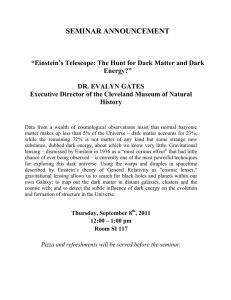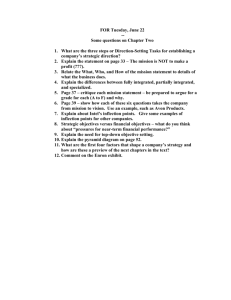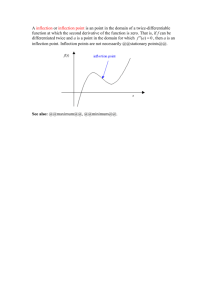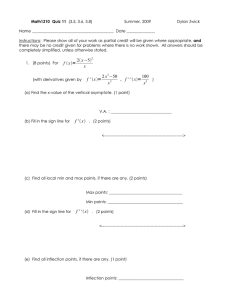Dark Energy and the Inflection Points of Cosmic
advertisement
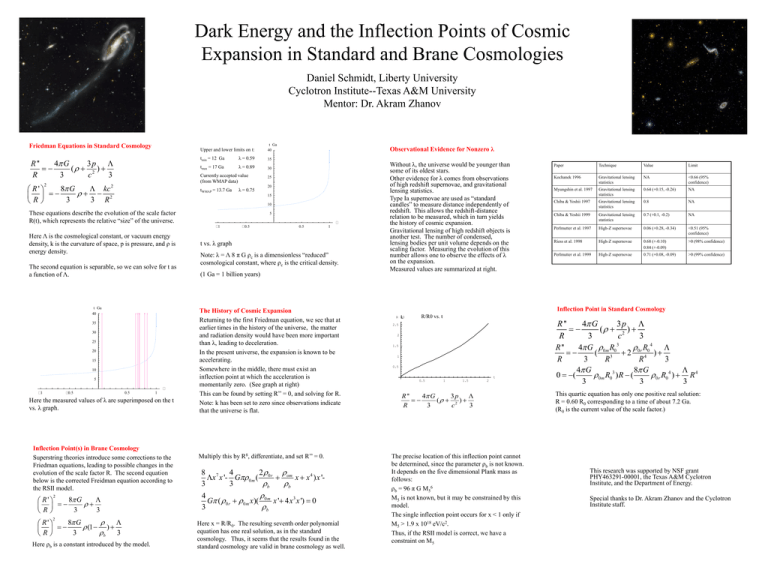
Dark Energy and the Inflection Points of Cosmic Expansion in Standard and Brane Cosmologies Daniel Schmidt, Liberty University Cyclotron Institute--Texas A&M University Mentor: Dr. Akram Zhanov Friedman Equations in Standard Cosmology Upper and lower limits on t: R '' 4 G 3p ( 2 ) R 3 c 3 tmin = 12 Ga λ = 0.59 35 tmax = 17 Ga λ = 0.89 30 Currently accepted value (from WMAP data) 8 G kc R' 2 3 3 R R 2 2 tWMAP = 13.7 Ga λ = 0.75 25 20 10 5 1 Here Λ is the cosmological constant, or vacuum energy density, k is the curvature of space, p is pressure, and ρ is energy density. The second equation is separable, so we can solve for t as a function of Λ. t Ga 40 35 30 25 20 15 10 5 0.5 Observational Evidence for Nonzero λ 15 These equations describe the evolution of the scale factor R(t), which represents the relative “size” of the universe. 1 t Ga 40 0.5 1 Here the measured values of λ are superimposed on the t vs. λ graph. Inflection Point(s) in Brane Cosmology Superstring theories introduce some corrections to the Friedman equations, leading to possible changes in the evolution of the scale factor R. The second equation below is the corrected Freidman equation according to the RSII model. 8 G R' 3 3 R 2 8 G R' (1 ) 3 b 3 R 2 Here ρb is a constant introduced by the model. 0.5 0.5 1 t vs. λ graph Note: λ = Λ 8 π G ρc is a dimensionless “reduced” cosmological constant, where ρc is the critical density. (1 Ga = 1 billion years) The History of Cosmic Expansion Returning to the first Friedman equation, we see that at earlier times in the history of the universe, the matter and radiation density would have been more important than λ, leading to deceleration. In the present universe, the expansion is known to be accelerating. Somewhere in the middle, there must exist an inflection point at which the acceleration is momentarily zero. (See graph at right) This can be found by setting R’’ = 0, and solving for R. Note: k has been set to zero since observations indicate that the universe is flat. Multiply this by R8, differentiate, and set R’’ = 0. 2 0 r om 8 7 4 x x '- G0 m ( x x 4 ) x '3 3 b b 0 m 4 G ( 0 r 0 m x)( x ' 4 x 3 x ') 0 3 b Here x = R/R0. The resulting seventh order polynomial equation has one real solution, as in the standard cosmology. Thus, it seems that the results found in the standard cosmology are valid in brane cosmology as well. Without λ, the universe would be younger than some of its oldest stars. Other evidence for λ comes from observations of high redshift supernovae, and gravitational lensing statistics. Type Ia supernovae are used as “standard candles” to measure distance independently of redshift. This allows the redshift-distance relation to be measured, which in turn yields the history of cosmic expansion. Gravitational lensing of high redshift objects is another test. The number of condensed, lensing bodies per unit volume depends on the scaling factor. Measuring the evolution of this number allows one to observe the effects of λ on the expansion. Measured values are summarized at right. Paper Technique Value Limit Kochanek 1996 Gravitational lensing statistics NA <0.66 (95% confidence) Myungshin et al. 1997 Gravitational lensing statistics 0.64 (+0.15, -0.26) NA Chiba & Yoshii 1997 Gravitational lensing statistics 0.8 NA Chiba & Yoshii 1999 Gravitational lensing statistics 0.7 (+0.1, -0.2) NA Perlmutter et al. 1997 High-Z supernovae 0.06 (+0.28, -0.34) <0.51 (95% confidence) Riess et al. 1998 High-Z supernovae 0.68 (+-0.10) 0.84 (+-0.09) >0 (98% confidence) Perlmutter et al. 1999 High-Z supernovae 0.71 (+0.08, -0.09) >0 (99% confidence) Inflection Point in Standard Cosmology R R0 R/R0 vs. t 2.5 2 1.5 1 0.5 0.5 1 1.5 2 t R '' 4 G 3p ( 2 ) R 3 c 3 The precise location of this inflection point cannot be determined, since the parameter ρb is not known. It depends on the five dimensional Plank mass as follows: ρb = 96 π G M56 M5 is not known, but it may be constrained by this model. The single inflection point occurs for x < 1 only if M5 > 1.9 x 1018 eV/c2. Thus, if the RSII model is correct, we have a constraint on M5 R '' 4 G 3p ( 2 ) R 3 c 3 3 4 0 r R0 R '' 4 G 0 m R0 ( 2 ) 3 4 R 3 R R 3 4 G 8 G 4 3 4 0 ( 0 m R0 ) R ( 0 r R0 ) R 3 3 3 This quartic equation has only one positive real solution: R = 0.60 R0 corresponding to a time of about 7.2 Ga. (R0 is the current value of the scale factor.) This research was supported by NSF grant PHY463291-00001, the Texas A&M Cyclotron Institute, and the Department of Energy. Special thanks to Dr. Akram Zhanov and the Cyclotron Institute staff.
